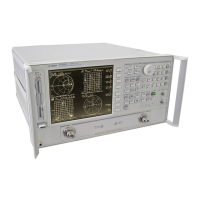5-56
Hardkey/Softkey Reference
Analyzer Functions
leads to the specify class menu. After the standards are
modified, use this key to specify a class to consist of certain
standards.
finishes the specify class function and returns to the
modify cal kit menu.
(Option 010 only) is used to specify the parameters of the
gate.
allows additional specifications for a user-defined
standard. Features specified in this menu are common to
all five types of standards.
toggles between a full-screen single graticule display or
two-, three-, or four-graticule, multiple-channel display.
Works with to determine the
number of channels displayed.
selects whether spur avoidance is ON or OFF. Selecting
spur avoidance OFF, along with selecting raw offsets OFF,
saves substantial time at recalls and during frequency
changes. Spur avoidance is always coupled between
channels.
returns to the define standard menu.
is used to define the start frequency of a frequency range.
When the key is pressed it becomes the active
function. The value is displayed in the active entry area,
and can be changed with the knob, step keys, or numeric
keypad.
is used to end the specify offset sequence.
is used to specify the type of calibration device being
measured.
defines the standard type as a transmission line of
specified length, for calibrating transmission
measurements.
defines the standard type as a load (termination). Loads
are assigned a terminal impedance equal to the system
characteristic impedance ZO, but delay and loss offsets
may still be added. If the load impedance is not ZO, use
the arbitrary impedance standard definition.
defines the standard type as an open used for calibrating
reflection measurements. Opens are assigned a terminal
impedance of infinite Ωs, but delay and loss offsets may
still be added. Pressing this key also brings up a menu for
defining the open, including its capacitance.
Start
Start

